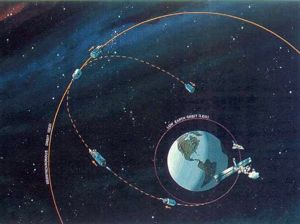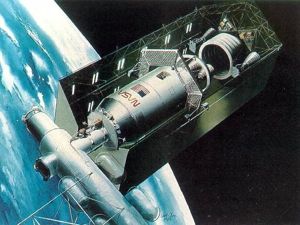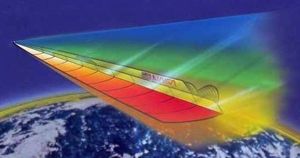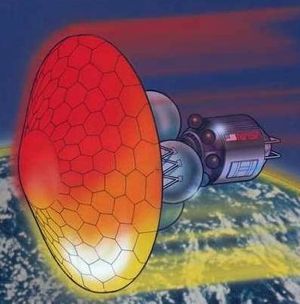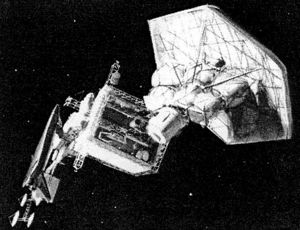
Home - Search - Browse - Alphabetic Index: 0- 1- 2- 3- 4- 5- 6- 7- 8- 9
A- B- C- D- E- F- G- H- I- J- K- L- M- N- O- P- Q- R- S- T- U- V- W- X- Y- Z
OTV
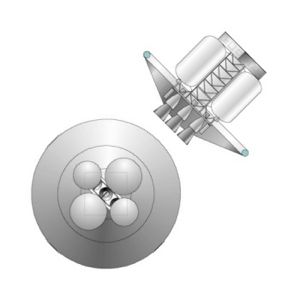 Otvmew Credit: © Mark Wade |
AKA: LTV;Lunar Transfer Vehicle;Orbital Transfer Vehicle. Status: Study 1985. Gross mass: 37,550 kg (82,780 lb). Unfuelled mass: 3,990 kg (8,790 lb). Specific impulse: 475 s. Height: 7.77 m (25.49 ft). Diameter: 7.47 m (24.50 ft).
It was an integral part NASA's space station, lunar and Mars exploration plans in the 1980's. Phase A study contracts were let in 1985-1989 to Boeing and Martin, but design and development never went any further than that.
NASA conducted advanced studies of what was then called the Space Tug in the early 1970's. However all elements of NASA's future vision of space exploration were cancelled to allow funds for development of the Space Shuttle. After the Shuttle was flying, NASA began studying the tug again, now dubbed the Orbital Transfer Vehicle (OTV). Studies in the 1970's had already considered use of an aerobrake heat shield. This would allow the Tug, on its return from geosynchronous orbit, lunar orbit, or interplanetary trajectories, to use the earth's atmosphere to brake to orbital velocity, after which it would maneuver, then rendezvous and dock with a Space Station for refurbishing, refueling, and reuse. Use of aerobraking offered significant weight savings in comparison to pure rocket braking to return to the station.
One of the Science and Applications Manned Space Platform's most important missions was to serve as a space harbor for missions to geostationary orbit, where most communications satellites were located. Large satellites would be delivered to SAMSP from Earth by the Space Shuttle for final assembly and checkout. An Orbital Transfer Vehicle would then transport the satellite to geostationary orbit. The OTV would be permanently based at the space station in low Earth orbit.
In July 1984 NASA defined Space Station development Work Packages. Marshall Space Flight Center was named the lead center for Space Station propulsion, including the OMV and OTV space tugs, and their accommodation and servicing at the station. The Center awarded a number of $1-million study contracts to Boeing and Martin Marietta for investigating orbital transfer vehicles during the next 15 months. The $1-billion OTV was planned to form part of the Space Station infrastructure in the mid-1990s. Important missions included delivery of large satellites (initially weighing 8 tons) to geostationary orbit, retrieval of satellites for servicing at the Space Station and (eventually) manned sortie missions to GEO and lunar orbit. The contractors were to investigate both Space Station-based OTVs as well as vehicles that would be returned to Earth by the Shuttle for servicing. OTV Phase B was scheduled to take place during FY 1986-87 with a request for proposals in FY 1986. Phase B would focus on a single system approach, and Phase C/D would start in FY 1988. A ground-based OTV could be operational by 1992 and a Space Station-based version by 1994-95.
NASA/JSC also awarded a study contract to Eagle Engineering Inc. in 1984 to examine the effects of advanced manned lunar and unmanned planetary missions on the Power Tower Space Station. The basic idea was to use the Station with a fleet of reusable OTV's for ambitious missions such as the unmanned biconic 8,890kg Mars sample return vehicle. The space tug would require a propellant load of 27,760 kg for this mission, which was scheduled for a November 1996 launch. Mission requirements for other envisioned OTV planetary missions are summarized below. Both reusable OTV's (which would return to the Station for reuse) and Expendable OTVs, which do not carry a 3,731 kg aerobrake, were planned (coded E or R in the list). All missions except Mars Sample Return would have used the Mariner Mk.II robotic spacecraft as payload carrier.
- Titan Probes/Saturn Orbiter. Launch: 4/1993. C3 velocity requirement: 50.5 km2/sec2. Requirement: 1 Expendable OTV with 6.34t payload, 53.54t total mass, 41.81t OTV propellant, 48.15t net new payload elements required to be launched for the mission. 109 astronaut man-hours would be required for payload fueling and integration.
- Mercury Orbiter. Launch: 6/1994. C3 velocity requirement: 18.7 km2/sec2. Requirement: 1 Reusable OTV with 5.63t payload, 41.62t total mass, 28.90t OTV propellant, 34.53t net new payload elements required to be launched for the mission. 106 astronaut man-hours would be required for OTV refurbishment, aerobrake removal, payload refueling and integration.
- Ceres Sample Return. Launch: 10/1994. C3 velocity requirement: 9.9 km2/sec2. Requirement: 1 Reusable OTV+1 Expendable OTV with 43.57t payload, 131.59t total mass, 75.47t OTV propellant, 119.04t net new payload elements required to be launched for the mission. 247 astronaut man-hours would be required for OTV refurbishment, aerobrake removal, payload refueling and integration, and sample retrieval.
- Mars Sample Return. Launch: 11/1996. C3 velocity requirement: 9.0 km2/sec2. Requirement: 1 Reusable OTV with 8.89t payload, 44.03t total mass, 27.76t OTV propellant, 36.65t net new payload elements required to be launched for the mission. 138 astronaut man-hours would be required for OTV refurbishment, aerobrake removal, payload refueling and integration, and sample retrieval.
- Kopff Sample Return. Launch: 7/2003. C3 velocity requirement: 80.7 km2/sec2. Requirement: 1 Reusable OTV+1 Expendable OTV with 8.38t payload, 92.49t total mass, 71.51t OTV propellant, 79.89t net new payload elements required to be launched for the mission. 236 astronaut man-hours would be required for OTV refurbishment, aerobrake removal, payload refueling and integration, and sample retrieval.
The OTV primary mission would have been to deliver 9t to geostationary orbit using a single stage and 18t payloads to lunar orbit using two OTV space tugs in tandem. Each OTV had a mass of 7t empty and carried up to 42t of oxygen & hydrogen propellant (engine Isp=455.4s). The primary lunar mission payload would be modules for a permanent 18-crew Moonbase in 2005-2015; as required by the plan developed by a Johnson Space Center team lead by Barney Roberts in 1984. A 3.5t expendable landing vehicle with 13.5t of propellant would land 17.5t Space Station-derived modules on the lunar surface. 100t of propellant would have to be launched per lunar mission; NASA proposed to develop a Shuttle-derived unmanned heavy-lift launch vehicle for this purpose. The Space Shuttle would transport the empty 21,000-kilogram lunar lander+payload to the Space Station, where they would rendezvous with the 100t propellant module. OTV's and other hardware would be integrated at a Space Station-based spacedock:
For manned lunar crew exchange missions, the OTV would carry 5,500kg or 8,000kg cylindrical passenger modules for 4 or 6 astronauts, respectively. The passenger OTV would rendezvous in lunar orbit with a 10,000kg 6-crew lunar lander which would be fueled by 4t of hydrogen brought from Earth and oxygen produced from lunar soil. This would reduce the launch requirement from Earth. The manned missions would also carry an expendable 7,600kg lander plus 3,250kg logistics module for life support of four crew members during lunar launching and landing.
The 1984 NASA/JSC plan called for the development of OTVs and lunar landers in 1995-2003 to permit the creation of small semi-permanent manned camp on the lunar surface in 2005-2006. The ultimate goal would be a self-sustaining moonbase by 2017-18. NASA/Johnson also regarded the space tug as an integral component of its Space Operations Center plan.
A modular OTV design was proposed by General Dynamics in 1984. Spherical tanks contained liquid hydrogen and oxygen propellant for the engines; three sets would be carried for manned or heavy-lift missions while one set would suffice for delivering smaller unmanned payloads.
A NASA/Marshall concept from 1985 was equipped with a huge disc-shaped aeroshell which slowed the vehicle down as it passed through the Earth's upper atmosphere. The space tug could then return heavy payloads from geostationary or lunar orbit without using any fuel to rendezvous with the low Earth orbit space station. Another NASA/Marshall space tug concept from 1985 would have had better maneuverability thanks to its aerodynamic shape, but it would also weigh more.
In November 1985 Martin and Boeing were finishing their Orbital Transfer Vehicle study contracts. By then the OTV was estimated to cost $2.75 billion. However NASA had now decided to pursue development of the less ambitious Orbital Maneuvering Vehicle first. This in turn was cancelled after costs had ballooned from $400 to $465 million by 1987. Meanwhile OTV Phase A studies were extended twice, and Martin was bought by Lockheed. NASA vacillated in its lunar and Mars mission architectures between launching the OTV aboard a shuttle, a heavy lift shuttle derivative booster, or even heavier lift vehicles. Each of these changes affected the assumptions regarding the OTV's allowable mass, heat shield diameter, and primary mission. The detailed mass breakdown indicated was for a typical Lockheed Martin design of July 1987.
The OTV figured in the 1986 'Pioneering the Space Frontier' policy report. These vehicles would transport crews and equipment from space stations in low Earth orbit to lunar orbit. The Orbital Transfer Vehicle concept was renamed by NASA the Lunar Transfer Vehicle in 1988 to stress its importance for manned lunar base missions. The LTV baseline was based on design work by Boeing, which had received a further $2.5-million 18 month Phase A study contract in June 1989. NASA also awarded a similar contract to Lockheed Martin. Boeing's LTV would provide transportation between Space Station Freedom and lunar orbit. The oxygen and hydrogen propellant (129.8t in all) would be stored in four 1.45-metric ton expendable fuel tanks. The empty tanks would be discarded in Earth and lunar orbit to reduce the mass of the vehicle; 10% more fuel would have to be carried if the tanks were returned to Earth orbit for reuse. The basic, reusable LTV weighed 8.1t empty and consisted of a propulsion / propellant / avionics module that held 7t of propellant for returning to Space Station Freedom from lunar orbit. A large aerobrake protected the vehicle as it performed an aerocapture maneuver to kill off excess speed by passing through the Earth's upper atmosphere. This would save rocket propellant but the aerobrake would be heated to more than 1000K so it was to be made of advanced thermal protection materials. Aerobrake reuse for five missions was assumed, with refurbishment and verification at Space Station Freedom. The LTV would transport a crew of four astronauts in an 8.4-metric ton passenger module as well as up to 22.4t of cargo in two external containers. Propulsion in this version was provided by four 89 kiloNewton-thrust AES engines (481s Isp).
Structure: 1,272 kg (2,804 lb). Heat shield: 704 kg (1,552 lb). Reaction Control System: 120 kg (260 lb). Navigation Equipment: 71 kg (156 lb). Electrical Equipment: 300 kg (660 lb). Miscellaneous Contingency: 520 kg (1,140 lb). Environmental Control System: 310 kg (680 lb).
Family: Space Tugs. Country: USA. Launch Vehicles: Space Shuttle. Propellants: Lox/LH2. Agency: NASA, Martin, Boeing. Bibliography: 4401, 4402, 4403, 4404, 4405, 4406, 4436.
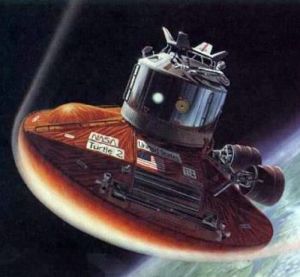 | Orbital Transfer Veh Credit: NASA |
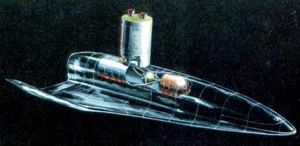 | OTV Credit: NASA |
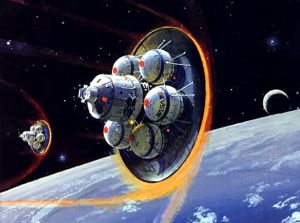 | OTV - 1986 Space Tug depicted in NASA's 'Pioneering Space Frontier'. A space tug from the 1986 Pioneering the Space Frontier policy report. Credit: NASA via Marcus Lindroos |
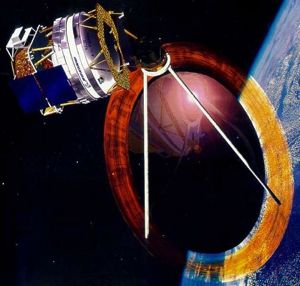 | SOTV - 1998 Solar-Powered Orbital Transfer Vehicle, 1998 Credit: NASA via Marcus Lindroos |
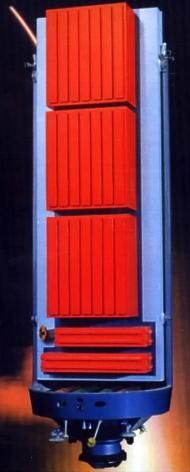 | Shuttle Tug Concept Credit: NASA via Marcus Lindroos |
Back to top of page
Home - Search - Browse - Alphabetic Index: 0- 1- 2- 3- 4- 5- 6- 7- 8- 9
A- B- C- D- E- F- G- H- I- J- K- L- M- N- O- P- Q- R- S- T- U- V- W- X- Y- Z
© 1997-2019 Mark Wade - Contact
© / Conditions for Use
